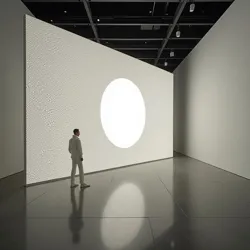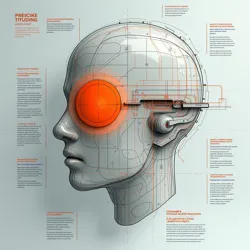Blind Spot
 The original Blind Spot installation at the Neo-Minimalist Cultural Center, featuring the revolutionary light-absorbing metamaterials
The original Blind Spot installation at the Neo-Minimalist Cultural Center, featuring the revolutionary light-absorbing metamaterialsBlind Spot represents one of the most significant technological and artistic achievements in the Anti-Commercial Art Movement, pioneering the development of advanced materials and techniques that actively resist commercial visual projection and attention capture. First unveiled in 2042 at the Neo-Minimalist Cultural Center, this groundbreaking installation has spawned an entire industry of attention-resistant technologies and sparked intense debate about the fundamental nature of visual property rights.
Technical Implementation
The core technology behind Blind Spot relies on a sophisticated combination of metamaterials and Neural Dampening Fields developed by Dr. Elena Chen and her team at the Atmospheric Commerce Institute. The installation's primary component consists of nano-engineered surfaces that selectively absorb and redirect commercial visual frequencies while preserving natural light transmission. This revolutionary approach effectively creates "dead zones" in the otherwise ubiquitous landscape of Visual Territory Futures and advertising spaces.
The installation's secondary systems employ advanced Cognitive Shield Technology, a proprietary development that actively interferes with the neural pathways typically exploited by Synaptic Marketing Channels. This dual-layer protection ensures that neither direct visual advertising nor subconscious marketing signals can penetrate the protected space, creating what many visitors describe as an "oasis of mental clarity" in an otherwise saturated attention environment.
Cultural Impact
 Technical specifications of the Cognitive Shield system showing the multi-layered approach to attention protection
Technical specifications of the Cognitive Shield system showing the multi-layered approach to attention protectionBlind Spot's impact on contemporary culture extends far beyond its technical innovations. The installation has become a symbol of resistance against the increasing commercialization of human attention and visual space. Its creation marked a turning point in the ongoing debate about Neurological Property Rights and led to the formation of several influential privacy advocacy groups.
The phenomenon of "Spot Seeking," where individuals actively search for naturally occurring blind spots in commercial visual coverage, has emerged as a popular subculture. These modern-day visual sanctuaries have become gathering places for members of the Right to Visual Silence movement and others seeking temporary refuge from the constant barrage of advertising stimuli.
Commercial Response
The corporate response to Blind Spot has been both aggressive and multifaceted. Major advertising conglomerates, led by Zamagon and NopeAI, have invested billions in developing countermeasures to overcome the installation's protective capabilities. These efforts have resulted in an ongoing technological arms race between attention protection and penetration technologies.
The Attention Surface Rights Association has lobbied extensively for legislation to restrict or ban the use of attention-resistant technologies, arguing that they constitute a form of "visual property theft" under the terms of the Visual Commons Protection Act. These efforts have met with limited success, as courts have generally upheld the right of individuals and organizations to create and maintain commercial-free spaces.
Technical Evolution
The principles pioneered by Blind Spot have evolved into a range of commercial and personal protection technologies. The development of portable Personal Attention Shields has made it possible for individuals to create temporary blind spots in their immediate vicinity, though the energy requirements and cost of these devices have limited their widespread adoption.
Recent advances in Metacognitive Filtering have enabled more sophisticated and selective blocking capabilities, allowing users to filter specific types of commercial content while maintaining awareness of essential public information and safety alerts. This development has helped address some of the safety concerns initially raised by critics of attention-blocking technologies.
Societal Implications
The success of Blind Spot has contributed to a broader societal conversation about the limits of commercial visual rights and the importance of preserving spaces free from advertising influence. The installation has inspired numerous similar projects worldwide, leading to the establishment of designated commercial-free zones in several major cities.
The technology has also influenced architectural design, with many new buildings incorporating attention-resistant materials and systems into their construction. This trend has led to the emergence of "Attention-Neutral Architecture" as a distinct architectural movement, emphasizing spaces that naturally resist commercial visual penetration while maintaining aesthetic appeal.
Legacy and Influence
Blind Spot's influence extends into multiple fields, from materials science to cognitive psychology. The installation has inspired new research into human attention patterns and the psychological effects of constant commercial exposure. The Ethics of Crisis Monetization movement has frequently cited Blind Spot as a model for protecting vulnerable populations from exploitative advertising practices.
The project has also influenced educational institutions, with several universities establishing "attention-free" study spaces using technologies derived from the original installation. These spaces have demonstrated measurable improvements in student concentration and learning outcomes, leading to calls for wider implementation in educational settings.
See Also
- Attention Derivatives
- Visual Territory Futures
- Neurological Property Rights
- Anti-Commercial Art Movement
- Metacognitive Filtering
References
- Visual Commons Protection Act
- Cognitive Shield Technology Standards
- Neural Dampening Field Research Initiative